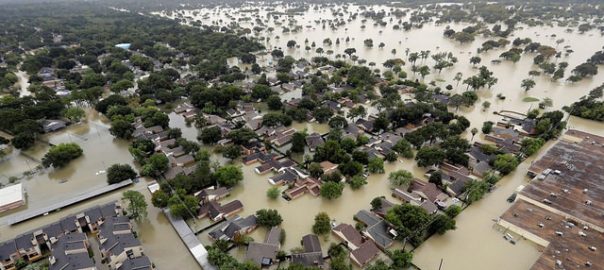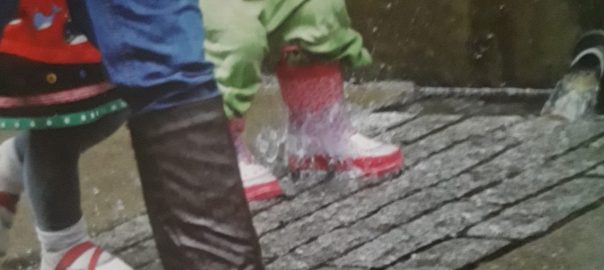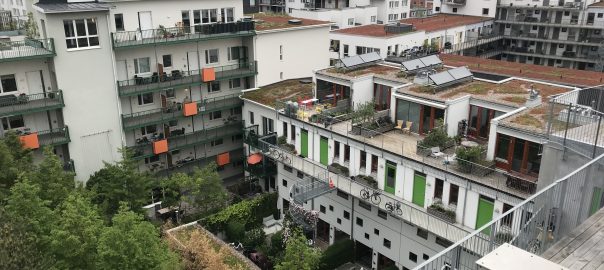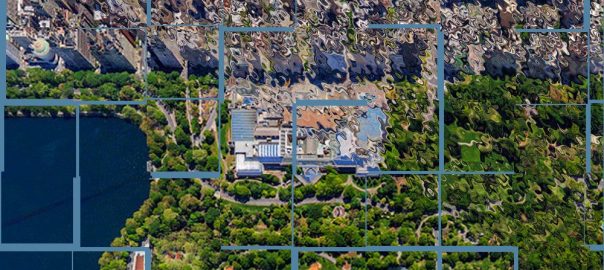New long-term development plans that do not integrate management of potential future climate conditions will put many people in harm’s way. The task is nothing short of a complete overhaul in planning practice, and a deep integration of fields that are historically divided.
However, climate change is now testing these assumptions by shifting local weather toward the unexpected, revealing a gap in what cities can withstand and the type, number, and magnitude of extreme weather events they will experience. The impact from hurricanes Harvey, Irma, and Maria, offer a sobering perspective on how the more predictable patterns of extreme weather events are changing, and how cities are indeed not isolated and that the built environment is highly vulnerable to impacts. Harvey and other events like it are occurring at a scale that we are currently unable to withstand or support. Climate models and scientists suggest that these extreme events are only the beginning of the shift we can expect for decades to come.
City planners are on the front lines of climate change adaptation, and their ability to implement effective changes, from policy and regulation to infrastructure and technology, will determine their city’s capacity to cope with the next big storm. Recent disasters are forcing an examination of how urban preparation, response, and recovery mechanisms require a redefining of cities as vulnerable ecosystems.
The task that city planners face is immense, and timing is critical because while we do not know exactly what or where, extreme weather is unavoidable, and will hit in unexpected places in unpredictable ways. With such immense uncertainty, planners and urban researchers must identify adaptation measures with the latest, yet incomplete understandings. These adaptations, many of which are still emerging, require however, recognition that cities are not monolithic, safe, and robust environments, and in fact may be the opposite. They are indeed vulnerable because they are places where social, technological, and biological components come together to impact human capacity to survive, particularly during extreme weather events.
Indeed, recent extreme events can be seen as justification for better integrating the functions of city offices—e.g., planning, transportation, parks, and emergency management—to couple changing social conditions, aging infrastructure, and advancing technology with the impacts of climate change. The processes that determine the prioritization and allocation of urban adaptation projects, i.e., protecting the historic downtown vs. a working-class community, partially determine who is likely to suffer most in extreme events. For example, why was there no city-assisted evacuation plan in place for the neighborhoods that were most impacted by Katrinai? How did the chemical plant explosions from Harvey impact those with the least access to or control over resources? These behind the scenes processes are often subtle and manifest institutionalized yet invisible processes of inequality such as bias, racism, and privilege though their outcomes.
To uncover some of these inconspicuous dimensions of prioritization processes for urban adaptation to climate extremes, we interviewed planners in five cities across the United States—Baltimore, Miami Beach, Portland (Oregon), Syracuse, and Phoenix—to identify the mechanisms that recreate, and potentially amplify social inequities. We wanted to know in detail why a particular event was impactful on the capacity of cities to withstand extreme weather events, and how current decision-making processes are interacting with the subtler forms of privilege that occur in city planning and politics. Although this research is in its early stages, we highlight a few key findings, which may help to shed light on preparation for the future extreme events.
The urban context matters
The complex development history of cities and the legacies inherited by residents and planners offer insights about the conditions that hamper urban climate adaptation efforts. These are, of course, unique circumstances for each city, consisting of powerful (empowered) individuals, institutions, and networks that lock-in development trajectories. For example, the development of Baltimore is facing entirely different issues than Miami Beach, and factors that go beyond biophysical and locational differences. While Baltimore was shaped by legacies of policy-supported racial segregation, Miami Beach arose as a tourism resort community, which arguably amplifies economic segregation between the new arrivals and those early European settlers. The heat vulnerability differential in Phoenix, where neighborhoods just two miles apart can experience a 13-degree temperature difference, can be partially explained by how the city grew and where immigrant communities live. Many former immigrant communities in Phoenix still have virtually no tree cover, making them some of the hottest and most exposed neighborhoods in the city.
The intersection of economics and vulnerability is particularly acute in North American cities. Miami Beach and Baltimore, are both threatened by rising sea levels and storm surges, yet Miami Beach is advancing adaptation responses, including major engineering projects to raise roads, houses, and whole neighborhoods, while Baltimore is expanding development on the flood plain because those areas provide developers the greatest return on investment. Since people who can afford the waterfront may also have greater access to government decision-making processes, owners of properties vulnerable to sea level rise can lobby city officials to fund protection systems. Instead of adaptation project money going to areas with long-standing social vulnerabilities due to processes (e.g., segregation) largely outside of residents’ control, limited city dollars may wind up supporting wealthy neighborhoods where residents choose to put their lives and property at higher risk. We learned that such trade-offs are occurring regularly in cities. In the Portland, Oregon area, a series of storms and consistent rainfall over two months in 2015 created landslides and road washouts that were largely in wealthier neighborhoods, and further impinged on the budget for important, but less critical, transportation infrastructure improvement projects that may be necessary in potentially less privileged areas of the city.
Rethinking “extreme events”
The aforementioned rain in 2015-2016 was the wettest winter ever in the Portland area, with over 25 days of consecutive rain. While not normally thought of as an extreme event, the rains caused flooding, landslides and other small localized problems ensued. We learned that these unusual or unexpected events are forcing planners into uncharted territory. Practitioners are now considering the cumulative effects of more frequent and intense, yet expected, weather (e.g., more rain, more days over 90 degrees). Duration and timing are becoming increasingly important aspects of weather. The planning moniker of “plan for the norm” is giving way to “prepare for the extremes”. Yet, environmental protection regulations and design guidelines still operate based on 100-year storms and utilize combined sewer overflow for storm events, and these policies are quickly outdated. In fact, interviewees suggested that annual seasons are shifting, where “summer” was characterized as 1 May–31 October, and “winter” from November 1–April 30, though if October becomes a winter month, as precipitation patterns already indicate, then compliance failures will likely occur, when combined storm and sewage flows increase. Governance planners will have to rewrite, indeed rethink, the regulations and re-allocate resources appropriately, which is a technical, economic, environmental, and political process.
Impacts on urban infrastructure
Practitioners in Syracuse, New York have jokingly said that Syracuse is one of the few beneficiaries of climate change due to the increase in pleasant, warm, and sunny days that have chased some of the rain clouds south. Climate change brings with it greater warmth to the northern areas, though it also brings extreme events, which they are experiencing as shifts in seasonal predictability. The 2016-17 winter in Syracuse was the “craziest winter” residents have ever experienced. In February, temperatures went up to 72 degrees (F) but dropped to 0 in March with a heavy snowstorm to boot. Plow drivers, who are normally employed through the winter were let go in February when winter seemed to be over. As a result, the snowstorm in March was met with a very sluggish response, which had rippling impacts throughout the social and economic fabric of the city.
More importantly, a record number of water main breaks in the city due to the recurring freeze-thaw cycles required the replacement and repair of the piping, which reveals a serious issue facing most of America’s cities: aging and inadequate critical infrastructure. These changes after the 2016-2017 winter in Syracuse have, however, made the city’s water infrastructure better able to withstand future temperature variability. City infrastructure, such as water and sewage, roads, rail and bridges, and electricity, are vulnerable to the specific policies and regulations that do not consider the increasing frequency, magnitude, and duration of extreme weather events. As weather patterns shift in unexpected ways, critical and secondary infrastructure will likely fail without intensive retrofitting. But city planners told us that their budgets are already thin, and funding for these projects is scarce, and likely not forthcoming.
Coinciding events create extreme conditions
In June of 2012, the surprise for Baltimore was not increased heat, which they expected, but wind, which they did not. The event that most stood out was what is called a “derecho”, a strong sustained and straight-line moving windstorm that occurred during a summer heat wave. Heat, as is becoming more widely understood, is the deadliest of weather conditionsii. City residents depended on air conditioning, fans, and cooling centers during the prolonged heat wave, when strong winds downed power lines across the city. How well residents weather a heat wave often correlates with measures of social capital, poverty, age, and raceiii. But this storm was indiscriminate, and high health risks reached across race and class lines. While food rotted in refrigerators, city residents sweated in the dark. With elevators frozen, people in high-rises became stranded in the unrelenting heat. Emergency management procedures and resources were not prepared for this kind of eventuality, and the city was hard-pressed to identify critical problems and act effectively, with lives in the balance. Much then depended on the social capital of individuals and families that can offer greater support during these extreme events.
Going forward
These select examples from the planners we interviewed suggest a need to reconsider the dominant narrative of city planning. What might be the advantages of considering cities as ecosystems that are vulnerable to climate change impacts? If we continue to think about cities as refuges to protect, then we will imagine higher walls, thicker levees, and technology that further separate humans from the ecosystems upon which we depend. But if cities are ecosystems and indeed complex and adaptive, then vulnerability becomes a product of the network of systems interacting and exchanging material and non-material goods and services. If we can think in terms of interaction, then we can imagine the complex exchanges that exist between a city and the weather patterns of the region and that the nature of those exchanges creates and define the city’s resilience to weather extremes. Adaptations, then, must mimic the complexity by addressing vulnerability and building resilience using a multiple-interacting criteria approachiv.
Permeability becomes an important organizational concept as we think about building resilience into cities. Permeability because, similar to ecosystems, attempts to wall off or close the flow of goods, services, information and other elements will increase vulnerability and likelihood of harm. Each city, as such, increasing its vulnerability as a result of greater isolation (less permeability) and increases the risk from extreme events. These must be addressed through the city’s cultural, political, and economic capacity. The cities we spoke with are well into this process. Like the concept of permeability, the following five themes were developed through our discussions with lead environmental planners. While not comprehensive, these themes are shaping the current practitioner perspective on cities as vulnerable ecosystems.
1. Historical context sets the stage. Patterns of development and policy reflect how the city has managed social, racial, and class tensions. Outcomes from these historical processes create not just the vulnerability context, but also form barriers to adaptation, change, and resilience building.
“[W]e are a city that’s developed on racism and racist policies…they adopted the ordinance of 1910 that basically allowed for white blocks and black blocks. Even though that was later invalidated, it was still a practice that was widely followed. Then bring in redlining maps—Federal Housing Administration support for racism in housing. We are a city that is essentially very segregated…That leads to huge differences in socioeconomic status throughout the city primarily based on race.”
— Baltimore
Beyond the social, political, and economic patterns that have and are shaping the city, the built environment is also critical. The development patterns a city has followed creates a path dependence in that it is deeply invested in one system of managing, e.g., stormwater, that it is too costly to implement a different, potentially better strategy. Therefore, planners and engineers often have to work within the current infrastructural context. In this way, management decisions of the past can determine a city’s future potential to weather extreme events that limit the adaptation potential of critical systems (e.g., stormwater, energy delivery, etc.).
The built environment also dictates how city residents interact with the city. The structure of spaces direct human accessibility, transportation preferences, and types and frequency of use. Interrupting these patterns may be critical in shifting the vulnerability of people in certain neighborhoods. Understanding the historical context allows planners and policy-makers to uncover why a city functions the ways it does, as well as how the city and residents have responded to imposed changes in the past, giving insight on how they will likely respond to future shifts. Questions for planners as they consider historical contexts in preparing for extreme events, include: What are the legacies that your city inherited from past policy and development, and how are they continuing to shape your current vulnerability context? How are historical patterns of infrastructure and investment influencing the adaptive capacity of the city, and stifling innovation?
2. Knowledge building is critical. Novel events and changing weather patterns are pushing cities into unknown territory. It is critical to examine city processes and event impacts to understand where gaps in response and preparation exist, as well as to understand new weather patterns as they are developing.
“That was a big event for us as far as impact on low-income residents, impact on elderly and youth, and just impact on our infrastructure systems, showing a lot of the vulnerabilities in our community, lack of understanding of where resources should be distributed, where we’re getting resources to, how effective that distribution was—or ineffective.”
— Baltimore
With novel events, it is also important to understand how a city’s current systems and residents respond. What new vulnerabilities are revealed? Essentially, it is necessary to understand how the city’s risk context is shifting. With Irene in 2011 and Sandy in 2012 FEMA flood maps were redrawn up and down the eastern seaboard. Understanding not just the event, but the interaction of the city with the event is a crucial step in effective and efficient adaptation.
Researchers have capacities that planners often do not, such as experimenting with innovative approaches and technologies. City planners and researchers can work together to assess urban vulnerability to extremes and to co-develop strategies that will have the best chance at positive strides toward building resilience.
“[T]he research historically has all been all over the map and giving opposing opinions of what to do and opposing solutions, and solutions that apply at the micro scale, but not at the macro scale, that it’s actually created inertia in doing anything.”
— Phoenix
Choosing the most effective path to prepare for extreme events may also incur large costs, take years to actualize, and potentially create a path dependence. Partnerships across academia, government, and communities can improve the sharing of knowledge and facilitate capacity building on all levels. Questions for building knowledge when preparing for extreme events include: What are the gaps between what your city is experiencing and the plans, protocols, and regulations in place to manage preparation and recovery from extreme weather? Is there a coordinated network of academic, non-profit, community, and government organizations that can co-produce and share knowledge? And importantly experiment with novel solutions to current problems?
3. There may be limits to change. As the climate continues to change the identity (e.g., tourist or recreational destinations, cultural or historic centers, historic districts, economic engines, etc.) of the city can become quickly threatened. Planners who work between adaptation and transformation, can anticipate strong push back against proposed changes. A city that needs to transform its identity, perhaps as a result of adaptation planning, will strongly resist abrupt change, but a long-term strategy can transform the built environment, behavior, and the economic base.
“[Retreat] is never going to be an option for Miami Beach, because what happens if we consider that option? First and foremost, residents don’t want to leave Miami Beach. There’s a reason they’re there, and they love it. Secondly, some of the most vulnerable areas are the touristic areas. If you propose some kind of retreat, you kill Miami Beach.”
— Miami Beach
Regardless if current systems are causing harm or creating vulnerability, there are some who risk great losses from change. Many groups, individuals, companies, and organizations have gained significantly in wealth and influence through the current organization of system elements. Indeed, many of those likely had a hand in shaping the current state to their benefit. If adaptation measures challenge their positions of power, then proposed changes may likely be ardently opposed. Questions that offer insights into the limits to change when planning for extreme events include: How can multi-scalar alignment be achieved; what are the conditions where residents, city management, business, and organizations are largely on the same page? What can you do to prepare for when those conditions arise? Can you identify areas that will be sources of powerful push back to proposed adaptation and develop strategies that engender goal alignment?
4. Align policy, processes, and infrastructure with conditions. Extreme weather, seasonality, temperatures, and more are in the process of change, which suggests that more surprises are likely. Regulations, policy, short- and long-term planning, and critical infrastructure capacity all need to be adaptable to at least match current conditions, but ideally made to proactively manage a broad range of potential conditions.
“The utilities have had to respond to the water main breaks, but I don’t see them being proactive. They’re reactive…There’s a whole network of emergency management people in NY state who are charged with being proactive and being prepared for emergency response. But the city, in some respects, seems to be declining in terms of its ability to respond, as a result of its financial constraints.”
— Syracuse
Understanding how city policies, regulations, services, and resource allocation mitigate harm from extreme weather events is necessary before engaging in this step, which aims to bridge the gaps. Knowing how and why current policies, infrastructure, etc. are failing will greatly facilitate enacting adaptation. However, it is not always possible, quick, or efficient to build that knowledge, especially when weather patterns are not stable year to year. Building in flexibility and adaptive potential to city management will allow for practitioners to make critical decisions at critical times. Questions for planning to align city systems when preparing for extreme events include: What policies, procedures, and regulations are outdated? And how are these impeding adaptation and the ability of the city to effectively manage current weather events? Can policy and regulation updates be made to allow for flexibility and adaptive capacity to anticipate a changing local and regional climate?
5. Build bottom-up capacity and cohesion. Expanding plans from a response and recovery focus to include preparation will be essential. With the recognition that the city cannot manage it all on its own, the community becomes critical. Consider how governance can facilitate developing community capacity and cohesion.
“We can see huge differences from neighborhood to neighborhood and how folks are checking in on each other and what the adaptive capacity is of that neighborhood…I think that something we’ve been realizing more and more each year and trying to incentivize as an element of all planning and implementation is—how do we strengthen communities and community ties?”
— Baltimore
Neighbors and neighborhoods play a critical role in managing extreme events. Localized networks that are active in and out of crises can ensure that there are avenues of aid and information for vulnerable people and families. Connecting these networks with city managers and emergency responders will allow coordination of efforts, streamline communication, and minimize confusion and potential panic. When people know who to contact, where to go, or how to react during crises, there is less burden on city personnel. This may even save lives and reduce negative health impacts especially in surprise or prolonged events such as heat waves. Questions for planners when facilitating community-based preparation for extreme events include: How can community members and organizations be empowered and become allies in climate adaptation, risk and emergency management, and awareness? What current networks and associations exist that can be tapped into and/or expanded to work together with city management and researchers?
* * *
As the dramatic repercussions from Hurricanes Harvey, Irma and Maria continue to unfold; the next storm is developing and aiming towards places that are vulnerable to major infrastructure, societal and ecosystem impacts. Collectively, we need to have an eye on next years’ storms, as well as those that will hit in 2030. If we are not actively trying to understand what can be done, then we’ll continue to face similar consequences.
On top of all of this, urban areas around the world are growing dramatically, with likely more than 6.4 billion residents in cities by 2050. How will cities accommodate their new millions, while ensuring some measure of protection from extreme weather? New long-term development plans that do not integrate management of potential future climate conditions will put many more people in harm’s way. The immensity of the task is nothing short of a complete overhaul in planning practice, and a deep integration of fields that are historically divided.
Darin Wahl and Vivek Shandas
Portland
Notes
i T. Litman, “Lessons from Katrina and Rita: What Major Disasters Can Teach Transportation Planners”, J. Transportation Eng., no. 1, pp. 11-18, 2006.
ii Luber G, McGeehin M. Climate change and extreme heat events. Am J Prev Med 2008;35(5):429–35.
iii Huang, G., Zhou, W., Cadenasso, M.L., 2011. Is everyone hot in the city? Spatial pattern of land surface temperatures, land cover and neighborhood socioeconomic characteristics in Baltimore, MD. Journal of Environmental Management 92, 1753–1759. https://doi.org/10.1016/j.jenvman.2011.02.006
iv Pelling, M., 2011. Urban governance and disaster risk reduction in the Caribbean: the experiences of Oxfam GB. Environment and Urbanization, 23(2), pp.383–400.
about the writer
Vivek Shandas
Professor Vivek Shandas specializes in integrating the science of sustainability to citizen engagement and decision making efforts. He evaluates the many critical functions provided by the biophysical ecosystems upon which we depend, including purifying water, producing food, cleaning toxins, offering recreation, and imbuing society with cultural values.







Leave a Reply